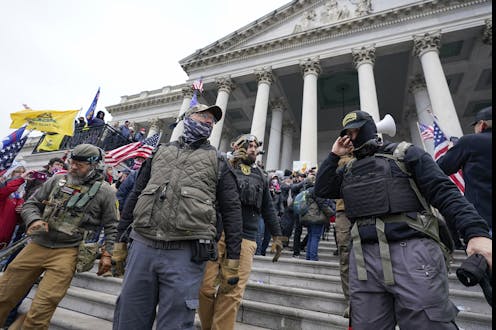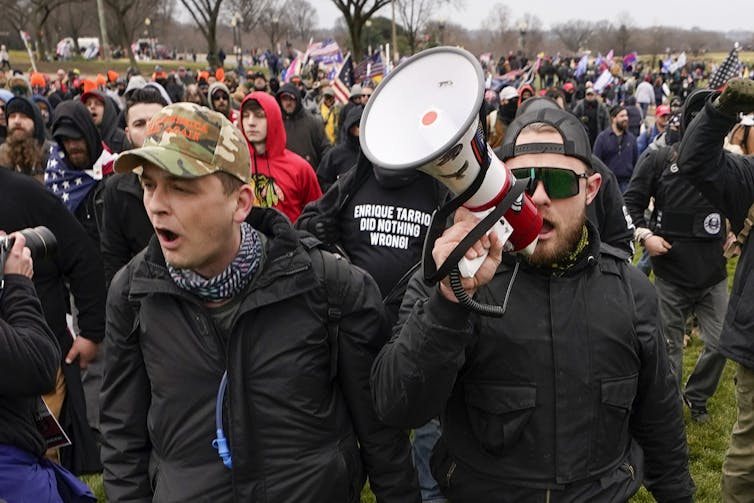Regardless of seditious conspiracy charges' outcome, right-wing groups like Proud Boys seek to build
White supremacist groups seek to solidify their control over the US by changing the government, sometimes by violence.

As the House Select Committee prepares to begin public hearings on the Jan. 6, 2021, insurrection, far-right groups including the Proud Boys and the Oath Keepers are slated to be a topic of discussion.
At the same time, both of those groups’ leaders are facing criminal charges of seditious conspiracy. They are alleged to have worked together “to oppose by force the authority of the Government of the United States.”
Those charges can be difficult to prove in court. But regardless of the outcome of any prosecution that alleges these groups worked to overthrow the government, our research has shown that the more committed members of these and other extreme right-wing groups believe that the U.S. government, as currently constituted, is illegitimate and should be overthrown and replaced with one that is based on white supremacy.
Violent racism
Proud Boys have identified themselves as “Western chauvinists” who focus on opposing political correctness and white guilt. But these claims have generally been seen as cover for deeper racist and antisemitic sentiments. For some Proud Boys members, this group was a steppingstone to more extreme groups, such as The Base.
Like any street gang, the Proud Boys as a national group is made up of semi-autonomous chapters of varying numbers and abilities. They are in different degrees of contact and coordination with other chapters. It’s not clear the level of interest – or capability – that most members have in actually following through with overthrowing the government.
Oath Keepers is an anti-government group that calls itself a “militia” focused on defending the Constitution and fighting tyranny. Former Oath Keepers spokesman Jason Van Tatenhove stated that the group is actually “selling the revolution,” meaning that the group is pushing conspiracy theories and propaganda to facilitate confrontations with federal law enforcement.
While members of the Proud Boys have concentrated their confrontations on anti-fascists or other protesters, Oath Keepers have participated in several armed standoffs against the government.
In 2014, the Oath Keepers joined an armed standoff between far-right patriot groups in Nevada on behalf of Cliven Bundy. In 2015, Oath Keepers showed up heavily armed in Ferguson, Missouri, during protests over the killing of Michael Brown. And in 2016, Oath Keepers were present at the armed takeover of the Malheur National Wildlife Refuge in Oregon.

A challenging road
Historically, prosecutions of seditious conspiracy charges succeeded against militant Islamist or Marxist groups.
But prosecuting far-right groups has tended to be much more difficult. In 1988, Louis Beam, a figurehead in the white power movement, and 13 white supremacists from groups such as the Aryan Brotherhood and the Ku Klux Klan were acquitted of conspiring to kill a federal judge and an FBI agent and plotting to overthrow the federal government to establish an all-white nation in the Pacific Northwest.
In 2012, charges of seditious conspiracy against members of Hutaree, a militant far-right Christian nationalist group, were dismissed after the judge concluded the government had not proved there was an actual conspiracy.
But it is clear from the charges stemming from the Jan. 6 insurrection – involving hundreds of alleged participants – that police and prosecutors are taking seriously the threat of violent action by Proud Boys, Oath Keepers and other far-right groups against individuals, organizations and local and national governments.
The authors do not work for, consult, own shares in or receive funding from any company or organisation that would benefit from this article, and have disclosed no relevant affiliations beyond their academic appointment.
Read These Next
People are getting their news from AI – and it’s altering their views
Even when information is factually accurate, how it’s presented can introduce subtle biases. As large…
Autocracies in transition: In 2025, Cameroon and Tanzania rulers clung to power — but look more vuln
The countries, whose respective leaders recently won widely disputed elections, offer contrasting examples…
Why are some Black conservatives drawn to Nick Fuentes?
Black Americans and white nationalists have joined forces in the past. And a number of cultural and…






